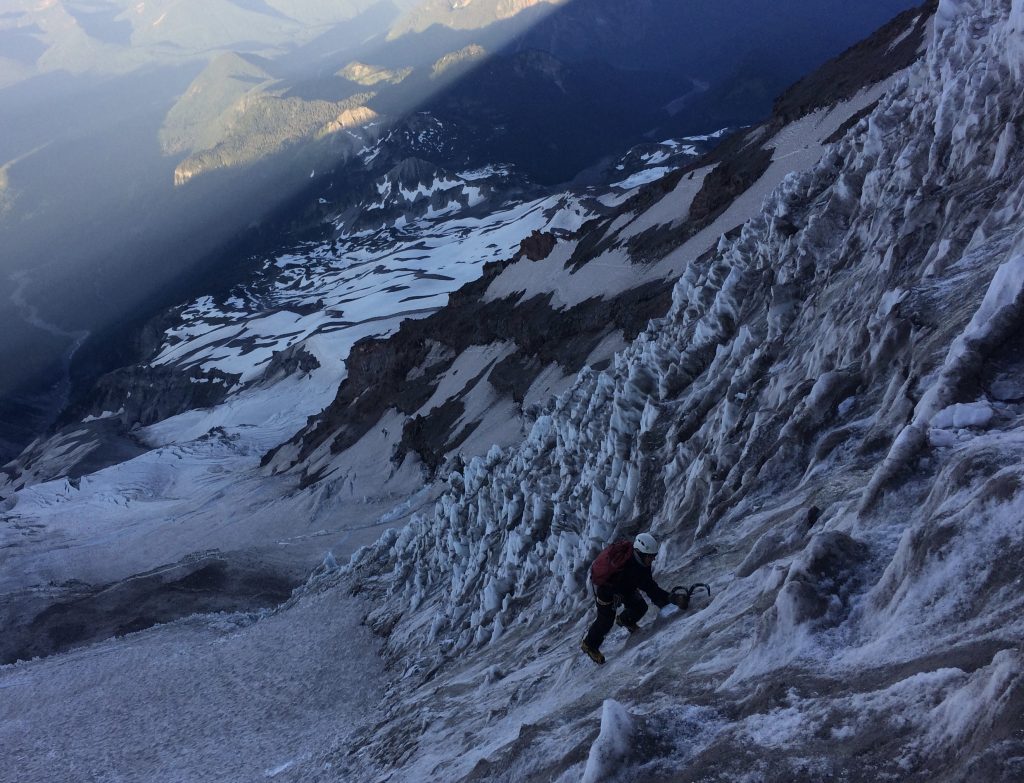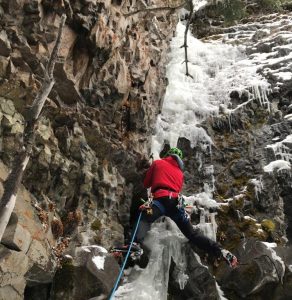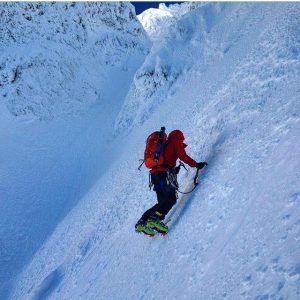February 23, 2019
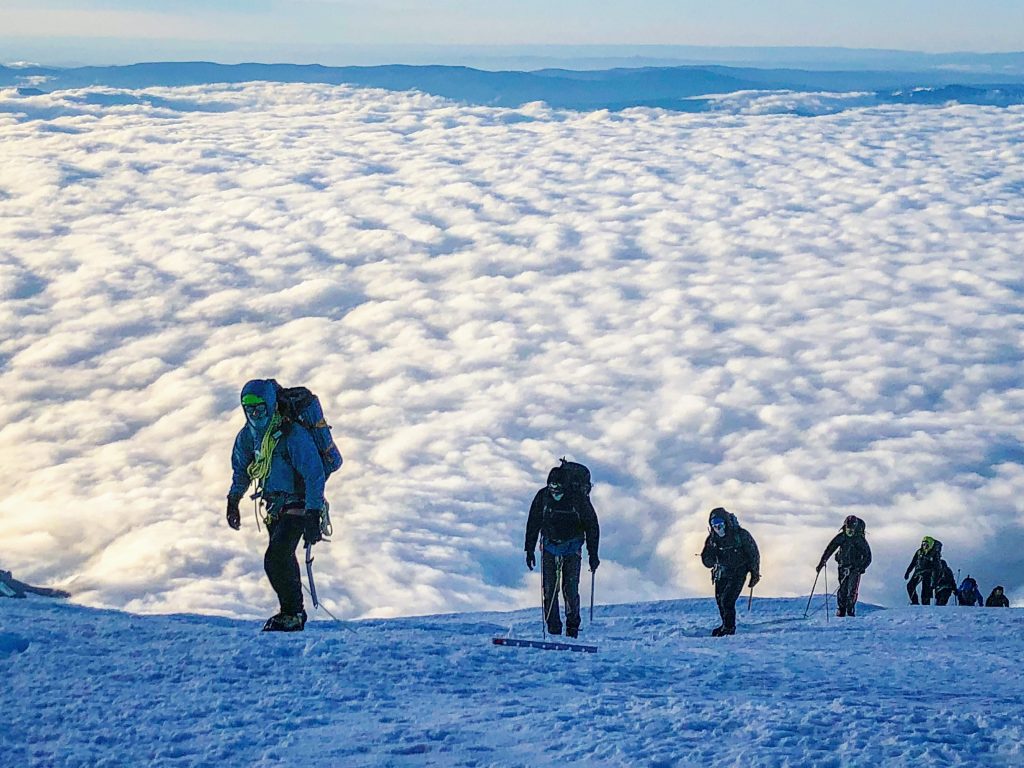
Porter leading a team up the Disappointment Cleaver Route using 10 point horizontal steel crampons (Dallas Glass)
Intro
There are several pieces of gear that are absolutely mandatory for climbing peaks such as Mt Rainier, and crampons are one of them. However, there are many types crampons and not all are created equal. We will discuss the differences in depth in this article. Some of the distinctions we will make include material, point configuration, and attachment method.
Steel vs Aluminum Crampons
Modern crampons are made from either steel or aluminum, depending upon the expected use. Aluminum crampons are intended for when weight is at a premium and every gram must be shaved from one’s pack, these crampons are frequently half the weight of their steel counterparts. However, aluminum crampons can break, bend, and wear down very quickly, therefore they are not a suitable choice for most of our climbing adventures and are not appropriate for any route on Mt Rainier. Steel crampons are a better choice for most scenarios. They won’t bend and they won’t wear down quickly when we walk on rock. They are heavier than aluminum but that is a sacrifice we must make in order to stay safe in the mountains. In my own climbing, I usually use steel crampons, but I will take aluminum crampons for ski mountaineering where I know I will not encounter rocks or hard ice, and I will only be using the crampons on the ascent. For Mt Rainier, steel crampons are mandatory.
12 Point vs 10 Point Crampons
This is the distinction that companies usually make between their entry level crampons and their more technical crampons. Typical crampons have 4 points on the heel piece, 2 front points, 2 secondary points and either 2 or 4 additional points on the toe piece. By having 4 additional points (making it a 12 point crampon) the secondary points can be moved farther forward. This results in more “stability†in very steep terrain because more than just your front points will be contacting the snow or ice. Therefore, 10 point crampons are considered less technical than 12 point crampons. As such, 12 point crampons will work for all standard mountaineering routes in the Cascades, while 10 point crampons will work for the routes that don’t have steep snow or ice. The 10 point crampons are designed for snow walking and offer less purchase on steep slopes, but they’re also lighter and cheaper. For Mt.Rainier, the Camp Muir/Disappointment Cleaver route and the Emmons Glacier route can be climbed with 10 or 12 point crampons. Every route we guide can be climbed with 12 point crampons.
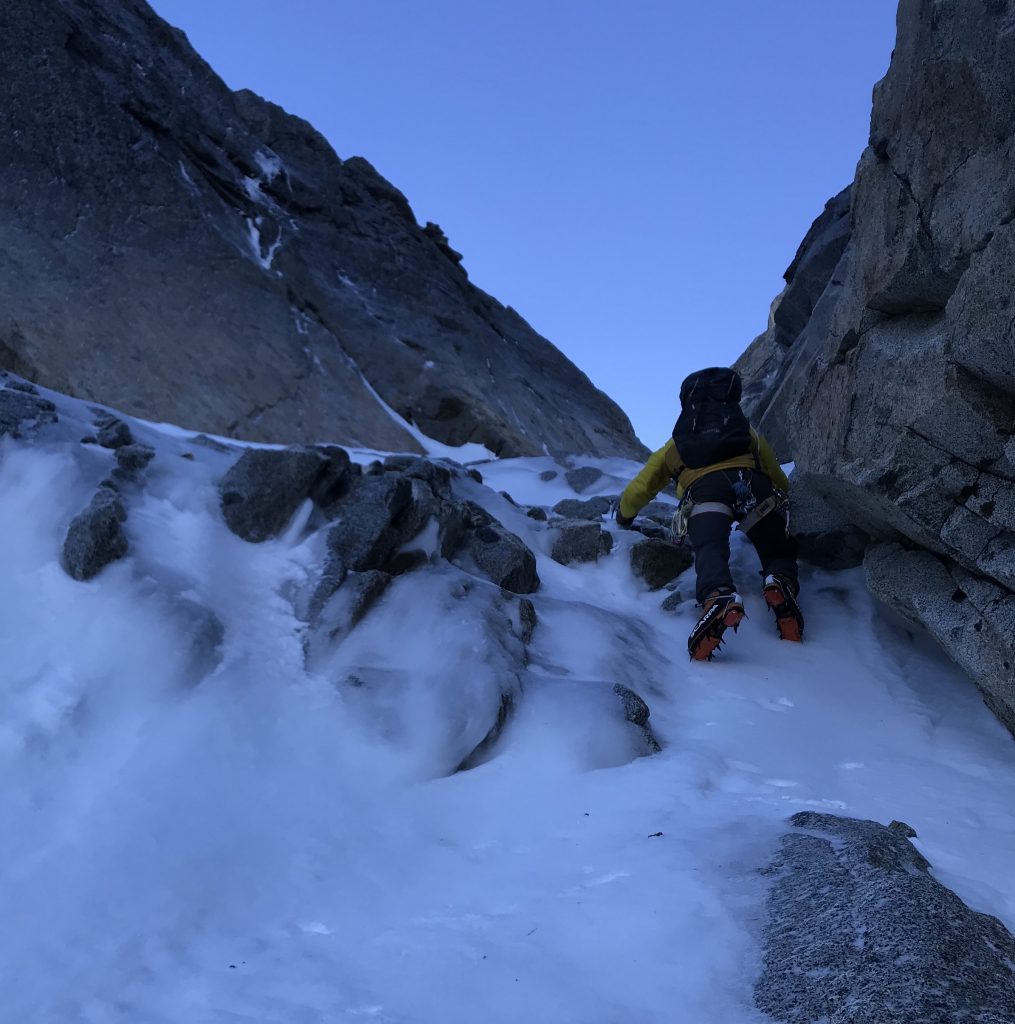
IMG Guide, Conrad Wharton, uses vertical front point crampons in technical terrain on Argonaut Peak. (Porter McMichael)
Horizontal vs Vertical Front Points
There are 2 orientations to choose from for the front points of your crampons. Either vertical or horizontal, depending on the terrain you expect to climb. We choose horizontal front points for the majority of routes on Mt Rainier because these crampons are lighter, simpler, less expensive, and the horizontal points can offer a slight boost in efficiency when walking on snow. Vertical front point crampons are designed for vertical terrain. We use these crampons for vertical ice and rock as the vertical points tend to stick better in ice and hold better on rock. However, these crampons are expensive and unnecessary for most climbers. I use vertical front point crampons for steep alpine ice routes and mixed routes (vertical rock and ice) but I use horizontal front point crampons for everything else. One important note is that some vertical front point crampons do not have anti-balling plates. This is a piece of rubber on the bottom of crampons that serves to prevent snow from building. This “balling†can be very dangerous and therefore I only recommend using crampons with anti-balling plates for mountaineering.
- Porter using vertical front point crampons in technical mixed terrain in Hyalite Canyon, Montana. (Abbey Thomas)
- Porter on the upper slopes of Colfax Peak using vertical front point crampons (Peter Butler)
Attachment Methods
There are 3 standard attachment methods for crampons. Strap, semi-auto, and fully auto. Strap crampons can be affixed to any footwear. They can go on hiking boots or even running shoes. However, it is very difficult to get a secure attachment with a strap system. Additionally, once put on, the crampons can loosen and fall off. I recommend staying away from strap on crampons. Semi-auto attachment crampons are quite secure and what I recommend for most climbers. These crampons have a plastic “bail†at the heel that cams onto a plastic ledge on the heels of most modern mountaineering boots, resulting in a very tight fit. The front of the crampon has a plastic loop that fits around the toe. When properly adjusted, this attachment results in your crampons having very little play between the crampon and the sole of your boot. Last is the fully auto system. These crampons have the same heel bail as the semi-auto crampons but have a wire toe bail that fits with the groove in the toe of fully rigid boots (only). When properly adjusted, this attachment results in your crampons having no play between the sole of your boot, which is great for very technical climbing. However, I have found fully auto crampons to be very finicky about boot/crampon fit and therefore I recommend you buy semi-auto crampons even if you have fully rigid boots unless you are experienced enough to assess boot/crampon fit. Strap, semi-auto, and fully auto are universal terms, and most companies use some different array of terms. This can be confusing, so make sure to ask and confirm that you’re getting the attachment type you want!
Putting it All Together
I know these distinctions can be confusing, so I will try to distill it down here. For the Disappointment Cleaver on Mt Rainier, you will need steel crampons, with either 10 or 12 points, and horizontal front points. This is the most common crampon and what I recommend most people buy as their first pair (in the 12 point, semi-auto configuration). There are countless crampons in the category but IMG’s rentals are Petzl Vasaks, these are a great option. If your goals are fast and light ski mountaineering on routes with low technical difficulty and no rock, then 10 point aluminum will be your best option. Finally, if you plan to climb a lot of steep ice then you will want steel vertical front point crampons. In this category, the Petzl Lynx is a great choice and works well in a lot of mountaineering roles. Remember, people climbed all the routes on Rainier with hand made steel crampons with no front points. Every steel crampon today is incredible, so don’t obsess over the tiny details.
How to Buy
Crampons are expensive. Even the cheapest 10 point models cost well over $100. It’s harder to find quality used crampons than it is boots or cloths. (Most crampons on the used market are very old and will work poorly compared to modern options.) Therefore, you will probably have to buy new crampons. If you own boots, take your boots to a retailer and try to find a crampon that fits the shape of your boot well. Many crampons will likely fit, choose which one fit your requirements, boot, and budget. Good luck and please reach out with any questions!
Feel free to email office@mountainguides.com or call 360-569-2609 with your questions and be sure to follow @porter.mcmichael and @intermationamountainguides on Instagram for inspiring pictures of the world’s great mountains and treks!
See you in the mountains!
Porter McMichael

